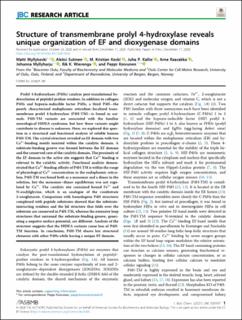| dc.contributor.author | Myllykoski, Matti | |
| dc.contributor.author | Sutinen, Aleksi | |
| dc.contributor.author | Koski, M. Kristian | |
| dc.contributor.author | Kallio, Juha Pekka | |
| dc.contributor.author | Raasakka, Arne | |
| dc.contributor.author | Myllyharju, Johanna | |
| dc.contributor.author | Wierenga, Rik K. | |
| dc.contributor.author | Koivunen, Peppi | |
| dc.date.accessioned | 2022-04-06T12:09:18Z | |
| dc.date.available | 2022-04-06T12:09:18Z | |
| dc.date.created | 2022-01-19T08:55:10Z | |
| dc.date.issued | 2021 | |
| dc.identifier.issn | 0021-9258 | |
| dc.identifier.uri | https://hdl.handle.net/11250/2990228 | |
| dc.description.abstract | Prolyl 4-hydroxylases (P4Hs) catalyze post-translational hydroxylation of peptidyl proline residues. In addition to collagen P4Hs and hypoxia-inducible factor P4Hs, a third P4H—the poorly characterized endoplasmic reticulum–localized transmembrane prolyl 4-hydroxylase (P4H-TM)—is found in animals. P4H-TM variants are associated with the familiar neurological HIDEA syndrome, but how these variants might contribute to disease is unknown. Here, we explored this question in a structural and functional analysis of soluble human P4H-TM. The crystal structure revealed an EF domain with two Ca2+-binding motifs inserted within the catalytic domain. A substrate-binding groove was formed between the EF domain and the conserved core of the catalytic domain. The proximity of the EF domain to the active site suggests that Ca2+ binding is relevant to the catalytic activity. Functional analysis demonstrated that Ca2+-binding affinity of P4H-TM is within the range of physiological Ca2+ concentration in the endoplasmic reticulum. P4H-TM was found both as a monomer and a dimer in the solution, but the monomer–dimer equilibrium was not regulated by Ca2+. The catalytic site contained bound Fe2+ and N-oxalylglycine, which is an analogue of the cosubstrate 2-oxoglutarate. Comparison with homologous P4H structures complexed with peptide substrates showed that the substrate-interacting residues and the lid structure that folds over the substrate are conserved in P4H-TM, whereas the extensive loop structures that surround the substrate-binding groove, generating a negative surface potential, are different. Analysis of the structure suggests that the HIDEA variants cause loss of P4H-TM function. In conclusion, P4H-TM shares key structural elements with other P4Hs while having a unique EF domain. | en_US |
| dc.language.iso | eng | en_US |
| dc.publisher | Elsevier | en_US |
| dc.rights | Navngivelse 4.0 Internasjonal | * |
| dc.rights.uri | http://creativecommons.org/licenses/by/4.0/deed.no | * |
| dc.title | Structure of transmembrane prolyl 4-hydroxylase reveals unique organization of EF and dioxygenase domains | en_US |
| dc.type | Journal article | en_US |
| dc.type | Peer reviewed | en_US |
| dc.description.version | publishedVersion | en_US |
| dc.rights.holder | Copyright 2020 The Authors | en_US |
| dc.source.articlenumber | 100197 | en_US |
| cristin.ispublished | true | |
| cristin.fulltext | original | |
| cristin.qualitycode | 2 | |
| dc.identifier.doi | 10.1074/JBC.RA120.016542 | |
| dc.identifier.cristin | 1984270 | |
| dc.source.journal | Journal of Biological Chemistry | en_US |
| dc.identifier.citation | Journal of Biological Chemistry. 2021, 296, 100197. | en_US |
| dc.source.volume | 296 | en_US |

